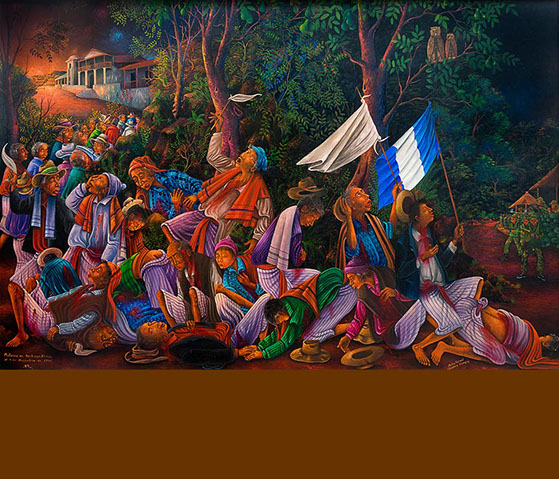About this painting by
Pedro Rafael González Chavajay

Mantanza en Santiago Atitlán
[Massacre in Santiago Atitlán]
1993. 36” x 54”
Victor Perera gives the clearest description of the massacre of civilians by the Guatemalan army in Santiago Atitlán (Perera 1993, 211):
On midnight of December 2, 1990, approximately twenty-five hundred Atitecos, led by the outgoing mayor, Delfino Rodas, and the mayor-elect, Salvador Ramírez, marched on the army barracks south of Santiago Atitlán and demanded to speak with the comandante. At the mayors’ urging, the marchers were unarmed and carried only sticks and white banners. Earlier that evening five plainclothes military, among them the base commander, had harassed several townspeople after drinking heavily in a local cantina. The comandante—who was apparently drunk—had attempted to rob the home of Andres Sapocu Jabuychan, and neighbors rang the churchbells to summon help. When a young man identified them as soldiers, the commanding officer fired his weapon, wounding a nineteen-year-old Atiteco in the hand and leg. Another youth apparently struck the officer in the face with a stone. The plainclothes soldiers gave themselves away when they had to be rescued by an army patrol, which escorted the officer and his four men back to the barracks.
The marchers were met by the comandante, who told their leaders to turn back and return the following day. According to eyewitnesses, an Atiteco toward the rear threw a stone at the comandante. A soldier fired into the air and a sergeant major manning an automatic weapon opened fire. Witnesses report that a courageous marcher threw himself on the gunner to prevent a slaughter, but it was too late. The soldier continued to strafe the crowd even after everyone fell to the ground or sought cover. When the shooting stopped, eleven men, women, and children lay dead on the ground, and at least twenty-one more were wounded. Two of these later died in the hospital. The final tally revealed most of the dead and wounded were Catholics, among them several catechists with Acción Católica.
The following day a clamor arose for the expulsion of the army garrison from Atitian. Father Tom McSherry quietly set up microphones in the square, as more than half the town’s twenty thousand residents gathered to hear the Attorney for Human Rights and other speakers demand the army’s removal. Mayor-elect Ramirez went on national TV to denounce the murder and the disappearance of two thousand Atitecos over the past eleven years. Before thousands of astonished viewers, he laid the blame squarely on the army.
In spite of the fact that a Maya town was finally able to stand up to the atrocities of the Guatemalan army, the peace accord had not yet been drafted or signed, and Pedro Rafael Gonzalez Chavajay knew that for him to paint this massacre posed a risk for him. I visited him within weeks of the massacre, and he was determined to depict the massacre in a painting. For my part I felt it was the most important theme he could paint, and that among the Tz’utujil artists, he was the only artist who would attempt it or do it justice. When I visited again the following year, he still hadn’t started it and the reason was clear. His house was always open during the day, and anyone could just walk into his studio at the front of the house and see what he was painting. He could hide a small or even medium size painting, but the large size that such a major painting required could not be disguised. Although he did not fear for himself, he feared for his family. I pledged to get him a visa so he could paint it in the United States. He did a sketch on the canvas, painted in the church and background, and told people who asked that this painting was a procession. He then brought it rolled up and finished it in San Francisco, coincidentally three years to the day from when the massacre occurred. During the time of violence during the early 1980s, around 200,000 Mayas were found murdered in similar circumstances.
I visited Santiago Atitlán with artist Mariano Gonzalez Chavajay a few weeks after the massacre, I now forget the reason but the experience left an indelible impression on me. The town was in mourning. Every entrance to a house or building in town had a black bow over the doorway. I was not prepared for what I saw when we reached the municipalidad (town hall) in the center of town. In the windows on either side of the door were photographs of over 500 people—on one side people who had been assassinated since around 1980, and on the other side, all the people who had just disappeared and never been found. Looking at the faces of the men, women, and children of all ages who lost their lives to the violence brought home how everyone in this town of around 20,000 had been touched. Nearly one out of every ten people had been murdered. I knew in my heart at that time that the military was responsible for most of these deaths, and that the top people in the military had been trained in the my country, the United States, and that we had supplied the military with many of their weapons. The president of the United States, the Congress, our military, and the people of the United States had all miserably failed these and other Maya in Guatemala. They paid with their lives for our fear of Communism, something which most of them knew nothing about.
Back to Pedro Rafael González Chavajay paintings page.